When Covering Isn’t…
Published on August 12th, 2019
Whether you’re into match racing or not, Dave Perry can make your sailing light-bulb a bit brighter. In The Dial Up match racing newsletter, Perry discusses covering tactics that can apply to all types of racing.
You have a one to two length lead up the first beat and are on starboard tack approaching your opponent on port tack. You want to “cover” them, so you cross them and tack one length to windward of them. You’ve got them right where you want them, right? Wrong. You just tacked in the worst possible place! (Diagram 1)
First of all, as soon as you complete your tack, your opponent can tack away. And when a boat is tacking, she isn’t sailing; she is coasting from one tack to the other. A boat will coast more quickly if there is less air pressure on her. By tacking one length to windward of your opponent, you actually let them do their tack in your disturbed air (less pressure), resulting in less of a loss than you just had in your tack.
Small gain to them. Dave Dellenbaugh taught me that one.
Second, let’s say it takes four boat lengths to get up to speed after a tack. If your opponent goes four lengths and tacks (“Speed build & Tack”), then when you tack, you will not be up to speed when you reach their line. You will again have to go at least one more length before you can tack. Otherwise, if you tried to tack on their line, you’d be tacking before you were up to speed which would be another small gain for them.
So where should you tack?
You could tack right on their line (imagine a straight line right through their boat – Diagram 2). They won’t be able to stay there because of your disturbed air, and they will be tacking away in maximum pressure. If you then go four lengths and tack (a “Speed build & Tack”), you will remain in their vicinity. And each time they tack, you will be up to speed when you get to their line and able to tack on their line again.
The payoff will come when they are on or near the port layline. Now when you tack on their line, they will have to either do two tacks and overstand, pinch to get clear air and lose distance, or get stuck in your gas and lose distance.
But there is a new risk to this position in match racing! The match racing rules delete rule 17 which is the rule that prohibits a boat that has established a leeward overlap from clear astern from sailing above her proper course.
The tactical result of that is if the port-tack boat can establish a leeward overlap on you after your tack, they can luff up to head to wind and force you to tack back onto starboard tack to keep clear of them. That is a terrible outcome for you!
But there is a better/safer place to tack. It is what Charlie McKee calls a “Soft Leebow.”
You tack just before you get to their line. (Diagram 3) This has several advantages. First, your opponent can’t see you (if they are sitting to windward), so they tend to stay on port tack for a while. Or your opponent thinks they can live to windward of you and maybe pin you from tacking later. Fool’s gold.
Once you are up to speed you simply shift into “high mode” (traveler up, little squeeze on the mainsheet, little ease on the backstay, boat a little flatter, sail inside your jib a bit, etc.) and you slowly work up under them. Soon they will realize they need to tack to clear their air and because you are up to speed you can tack right with them. Now you are finally in phase with them and can match their tacks (tight cover) for the rest of the beat.
Let’s say you are within five or so boat lengths of the starboard layline and you are concerned that if you tack to leeward of P, P will be able to live long enough to pin you past the starboard layline and will lead you into the mark, but if you let P duck you, they will be able to tack up to windward and be pinning you with the starboard tack advantage. No problem! Use the Soft Slam. (Diagram 4)
This begins with you hunting (bearing away) and forcing P to bear away further to keep clear of you (note, the match racing rules turn off rule 16.2, the anti-hunting rule). You then begin turning up so you are close-hauled when P’s bow is at your transom; this is key! You then count to 2 (“1-2”) and tack. You will be just far enough to windward of P that she can’t luff and get to you.
She will likely be able to tack out but that’s okay; you defended the right and can tack back on or just under the starboard layline. And if she hesitates for a second she will be pinned below you and you can easily pin her past the starboard layline and lead her into the mark.


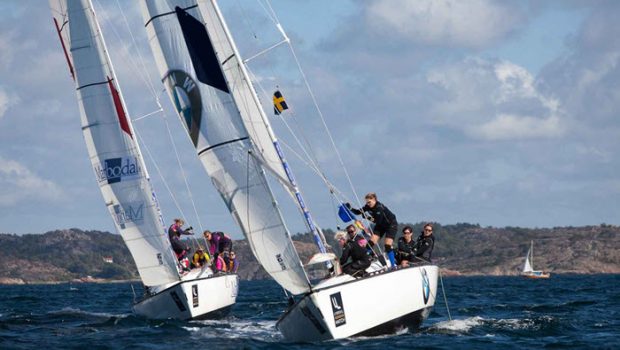






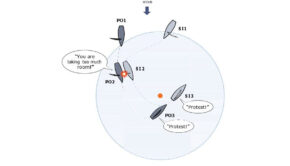
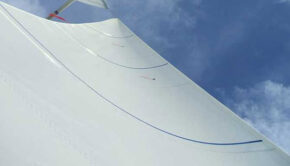
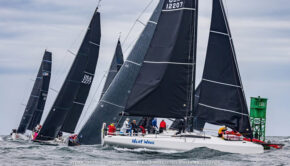
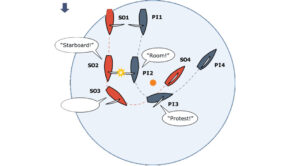
 We’ll keep your information safe.
We’ll keep your information safe.